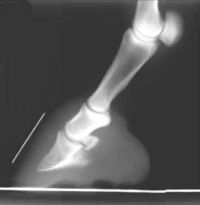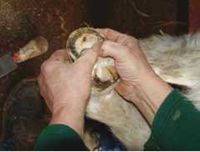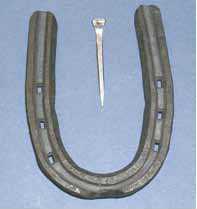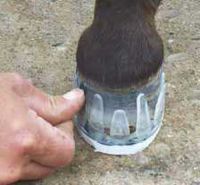Foot Normal - Donkey
Introduction




The natural habitat of donkeys consists of sparse, fibrous vegetation on which they graze, travelling over great distances in semi-desert environment. They live to approximately 10-15 years. In developed countries, they are kept as pets in characteristically damp temperate climates with plenty of rich grazing and little exercise. They often live beyond 30 years of age. Consequently, it is almost inevitable that hoof problems develop under these conditions.
To minimise such problems, good hoof care is essential.
- Daily hoof care
- Regular routine farriery
- Correct feeding
- General health care
Structure
Basic structure is similar to other equids, however, there are significant differences.
- The capsule is more upright and 'boxy' with a more u-shaped profile of the bearing surface of both front and hind feet
- The heels are often strongly developed and flared (heel buttresses)
- Wall thickness is generally uniform from toe to heel as opposed to tapering thickness towards the heel in the horse
- The frog appears less intimately connected with the other structures of the hoof capsule
- Microscopically, horn tubule size is generally larger than in the horse, less dense and not arranged in distinct zonal populations
- The moisture content is significantly higher in the donkey (from studies of donkeys within the U.K. Hopegood et al, 2003)
- Donkeys are more sensitive to wet conditions than horses (see Laminae Disorders in horses), they absorb moisture much more readily
- The donkey hoof wall is more pliant and deformable (Hopegood et al, 2003)
- The extensor process of the distal phalanx may be below the upper limit of the hoof capsule in normal feet - interpret radiographs accordingly
Routine trimming
Many donkeys are not used to handling and owners should be encouraged to do that, examine all feet and pick out any debris. However, beware of excessive lifting of arthritic limbs as this may cause discomfort.
- Generally every 6-10 weeks
- Assess for evidence of chronic laminitis
The sole Attend to the sole first, remove all loose and necrotic material, paring back any overgrown frog. The frog often becomes large and bubous with grooves and sulci. These may retain debris and infection. The frog should be trimmed to a neat triangular shape. The sole does not tend to flake away like in the horse. Therefore frequent parring is required to minimise the sole area in contact with the ground. Pare out in increments until thumb pressure between the apex of the frog and the toe causes the sole to yield perceptibly. It is often impossible to maintain concave sole with the ground in animals with chronic foot disease. The bars may be trimmed to facilitate daily cleaning but are probably best retained in driving or ridden donkeys.
The wall The wall should be trimmed aiming for a straight hoof pastern axis. The well developed coronary band may be misleading, suggesting that the natural hoof pastern axis may be broken forward. The actual angle of the hoof wall of the donkey is more upright than in the horse. The medio-lateral balance should be assessed and adjusted so that the weight is transmitted equally across the width of the foot. Excessive rasping of the external layers of the hoof capsule should be avoided, however, it is often necessary in chronic foot disease. The hoof wall needs to be brought back into parallel alignment with the underlying dorsal cortex of the distal phalanx. The most proximal aspect of the hoof capsule at the midline is a useful guide to such treatment. The balance, gait and comfort should be assessed after trimming and appropriate advice given to the owners on future management, feeding and general health care.
Shoeing
Hand-forged shoes can be helpful on the forefeet of some driving donkeys, especially those doing road work. Plastic glue-on shoes are a practical alternative to bandages post-surgery or when thin soles are traumatised continuously. Synthetic plastic adhesive materials have been successfully used to rebuild or replace the hoof wall to alleviate excessive pressure on the sole.
Donkey Foot Care Advice Factsheet
Literature Search
Use these links to find recent scientific publications via CAB Abstracts (log in required unless accessing from a subscribing organisation).
Donkey hoof anatomy publications
References
- Crane, M. (2008) The donkey's foot In Svendsen, E.D., Duncan, J. and Hadrill, D. (2008) The Professional Handbook of the Donkey, 4th edition, Whittet Books, Chapter 10
- Hopegood, L., Abraham, D., and Shervey, C. (2003). ‘Tubule density at different sample sites around the stratum medium of horse hoof horn’. Comparative Biochemistry and Physiology 134/A:3/Suppl, S55-56.
- Hopegood, L., Collins, S., Cope, B., Latham, R., Newlyn, H., and Reilly, J.D. (2003). 'The Effect of manipulation and modulation of moisture content on mechanical properties of full and partial hoof wall depth samples of donkey hoof horn samples'. Comparative Biochemistry and Physiology 134, suppl. S44.
- Hopegood, L., Collins, S., Latham, R., and Reilly, J.D. (2003). 'Analysis of the Moisture Content of Hoof Horn from Horses, Donkeys and Laminitic Donkeys'. Emerging Equine Science, Proceedings of the British Society of Animal Science, Cirencester, 15-16 September 2003. p 28.
|
|
This section was sponsored and content provided by THE DONKEY SANCTUARY |
|---|
